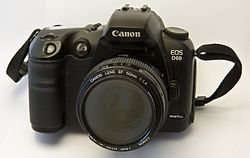 | |
| Overview | |
|---|---|
| Maker | Canon Inc. |
| Type | Single-lens reflex |
| Lens | |
| Lens mount | Canon EF |
| Lens | Interchangeable |
| Sensor/medium | |
| Sensor | 22.7 x 15.1 mm CMOS |
| Maximum resolution | 3,072 × 2,048 (6.3 megapixels) |
| Film speed | 100-1000 in 1 EV steps |
| Storage media | CompactFlash |
| Focusing | |
| Focus modes | One-shot, AI Servo, AI-Focus, Manual |
| Focus areas | 3 focus points |
| Focus bracketing | none |
| Exposure/metering | |
| Exposure modes | Full auto, programmed, shutter-priority, aperture priority, manual |
| Exposure metering | TTL, full aperture, zones |
| Metering modes | Evaluative, Partial, Center Weighted |
| Flash | |
| Flash | pop-up |
| Flash bracketing | none |
| Shutter | |
| Shutter | electronic focal-plane |
| Shutter speed range | 30 to 1/4000 s |
| Continuous shooting | up to 5.4 frame/s |
| Viewfinder | |
| Viewfinder | Optical |
| Image processing | |
| White balance | 7 presets, Auto and custom |
| WB bracketing | none |
| General | |
| LCD screen | 1.8 in (46 mm), 114,000 pixels |
| Battery | Li-Ion BP-511 rechargeable |
| Optional battery packs | BP-511A, BG-ED3 |
| Weight | 780 g (28 oz) (body only) |
| Made in | Japan |
| Chronology | |
| Predecessor | Canon EOS D30 |
| Successor | Canon EOS 10D |
The Canon EOS D60 is a discontinued 6.3 megapixel digital single lens reflex (DSLR) camera body, announced by Canon on February 22, 2002. [1] It is part of the Canon EOS range, and accepts Canon EF, TS-E and MP-E lenses, but not Canon's later digital-only EF-S lens range.
Contents
The EOS D60 sits in the prosumer (professional-consumer) line of digital SLR cameras. [2] It succeeded the three megapixel EOS D30 and was replaced by the improved, six megapixel EOS 10D.
In America, its initial pricing was US$1,999 for the basic body, or US$2,199 including battery, charger, and DC kit. [1]